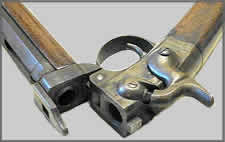- 01: Introduction
- 02: History
- 03: Propellants, Firearms, and Ammunition Development
- 04: Modern Firearms Manufacture
- 05: Small Arms Ammunition
- 06: Evidence Handling Procedures
- 07: Equipment and Instrumentation
- 08: Examination of Firearms
- 09: Cartridge and Shotshell Examination
- 10: Characterization and Evaluation of Fired Projectiles
- 11: Bullet Comparison and Identification
- 12: Gunshot Residue and Distance Determination
- 13: Toolmark Identification
- 14: Communicating Results
- Resources


Breech-Loading Firearm Design
Home > Propellants, Firearms, and Ammunition Development > Evolution of Firearms > Breech-Loading Firearm Design

Paper cartridge
Dating back to flint-fired models, breech-loading firearms were very complex and expensive. During the percussion cap era, breechloaders proliferated. Nearly all used a “cartridge” that consisted of paper or linen wrapped around powder and a ball. Variations of cartridges containing a projectile and propellant existed for many years, yet they still relied on an externally mounted percussion cap.
To evolve from the percussion cap to a completely self-contained cartridge, three things had to happen:
- The hammer blow had to be transferred to the interior of the arm where the cartridge rested.
- The arm had to be breech loaded, which required an open end opposite the muzzle to accept true cartridges (projectile, propellant, and primer).
- A locking mechanism on the arm was required to contain the cartridge during the pressure of firing.

Breech-loading firearm
To satisfy the first requirement, a rod was placed between the hammer and the now remote cap. This allowed the hammer to fall on the rod (firing pin), driving it into the cartridge cap, now called a primer. In some designs (notably revolvers), the cartridge was not so remote as to require a separate part; the firing pin could be as simple a small protrusion on the nose of the hammer.




